Nursing Workforce in Australia: Characteristics, Distribution, and Recommendations
VerifiedAdded on 2023/06/14
|12
|2160
|146
AI Summary
This study analyzes the nursing workforce in Australia, including characteristics, distribution, and recommendations for improvement. The report includes data tables, figures, and recommendations for building workplace capacity, supporting early career preparation, and enabling innovation in the workplace.
Contribute Materials
Your contribution can guide someone’s learning journey. Share your
documents today.
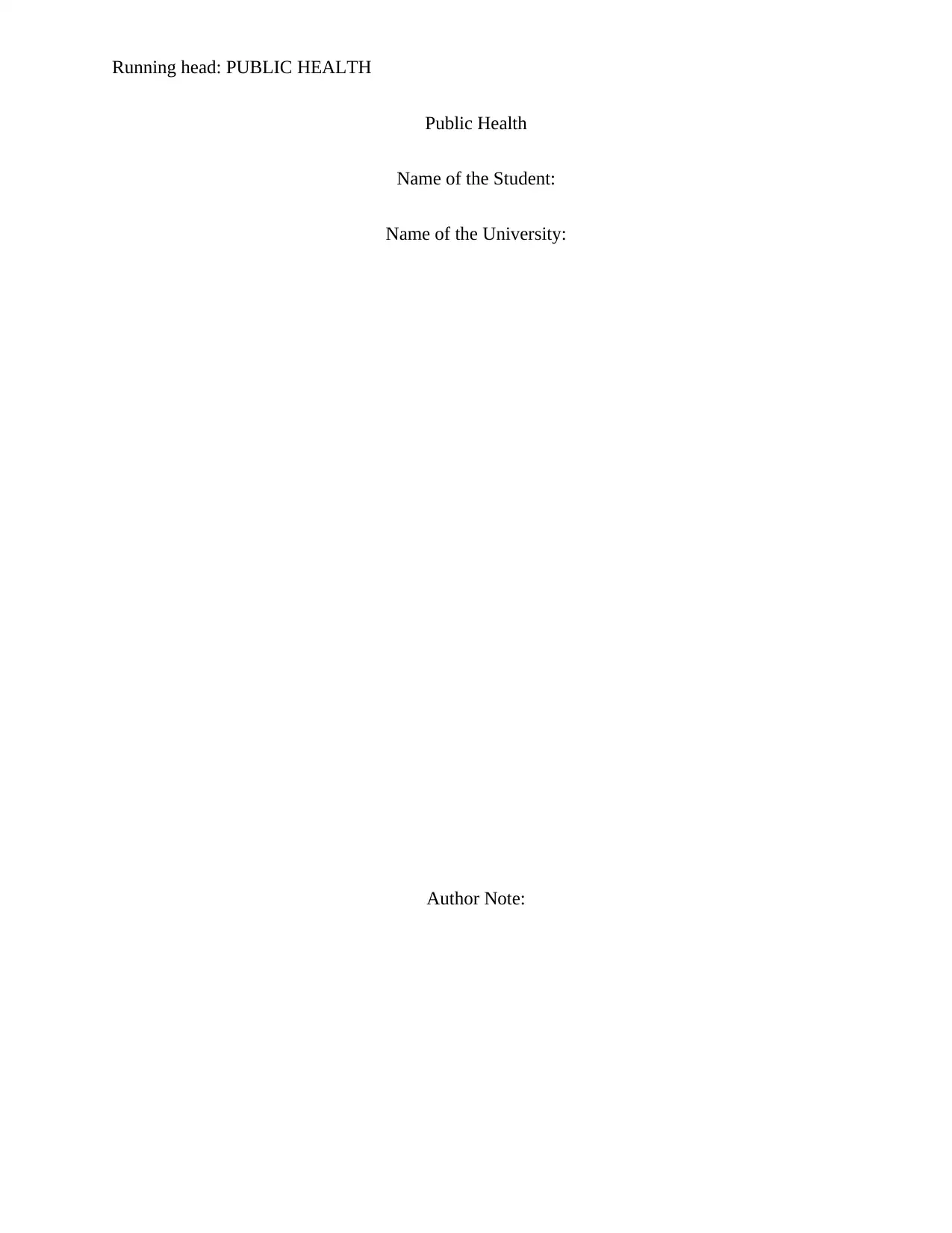
Running head: PUBLIC HEALTH
Public Health
Name of the Student:
Name of the University:
Author Note:
Public Health
Name of the Student:
Name of the University:
Author Note:
Secure Best Marks with AI Grader
Need help grading? Try our AI Grader for instant feedback on your assignments.
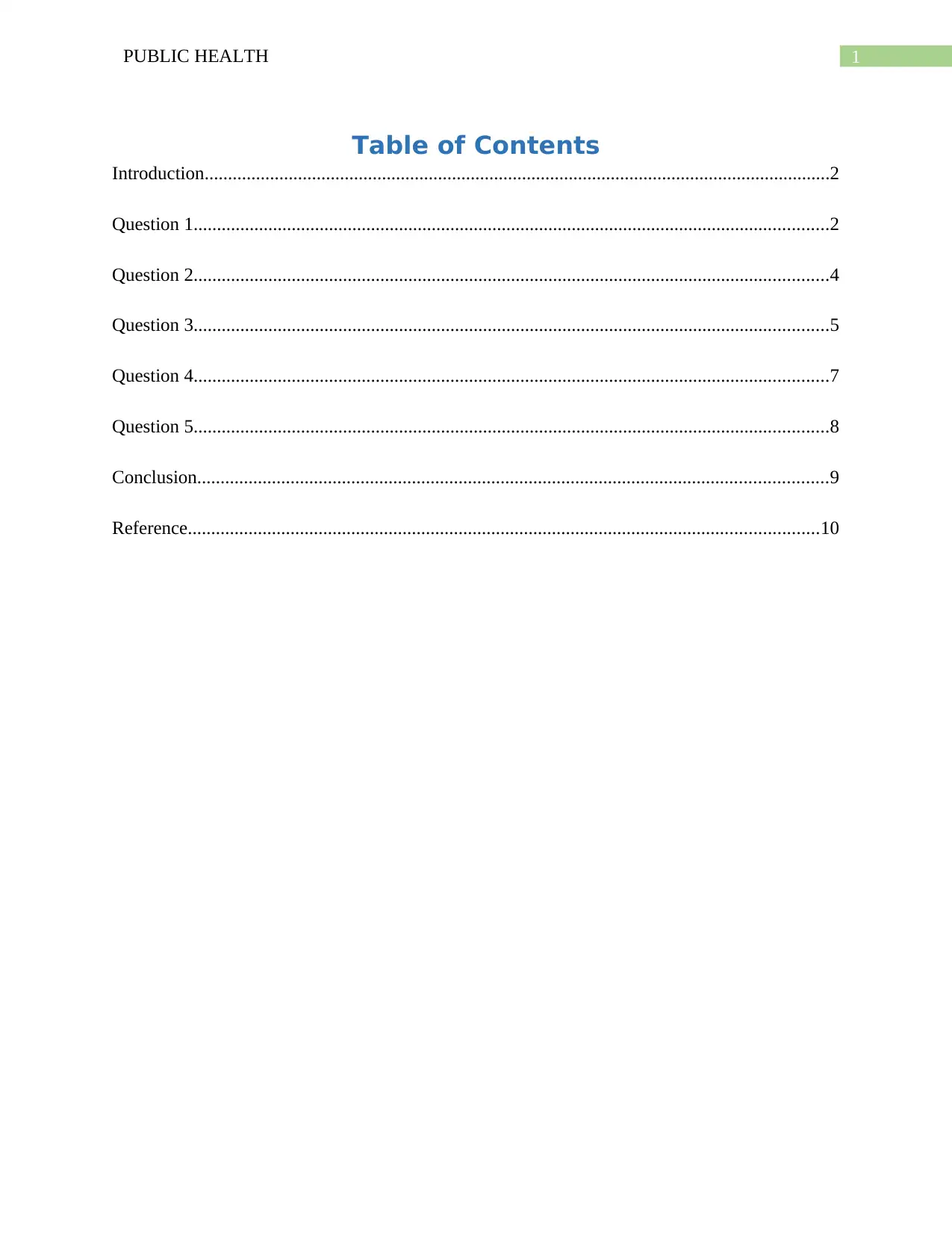
1PUBLIC HEALTH
Table of Contents
Introduction......................................................................................................................................2
Question 1........................................................................................................................................2
Question 2........................................................................................................................................4
Question 3........................................................................................................................................5
Question 4........................................................................................................................................7
Question 5........................................................................................................................................8
Conclusion.......................................................................................................................................9
Reference.......................................................................................................................................10
Table of Contents
Introduction......................................................................................................................................2
Question 1........................................................................................................................................2
Question 2........................................................................................................................................4
Question 3........................................................................................................................................5
Question 4........................................................................................................................................7
Question 5........................................................................................................................................8
Conclusion.......................................................................................................................................9
Reference.......................................................................................................................................10
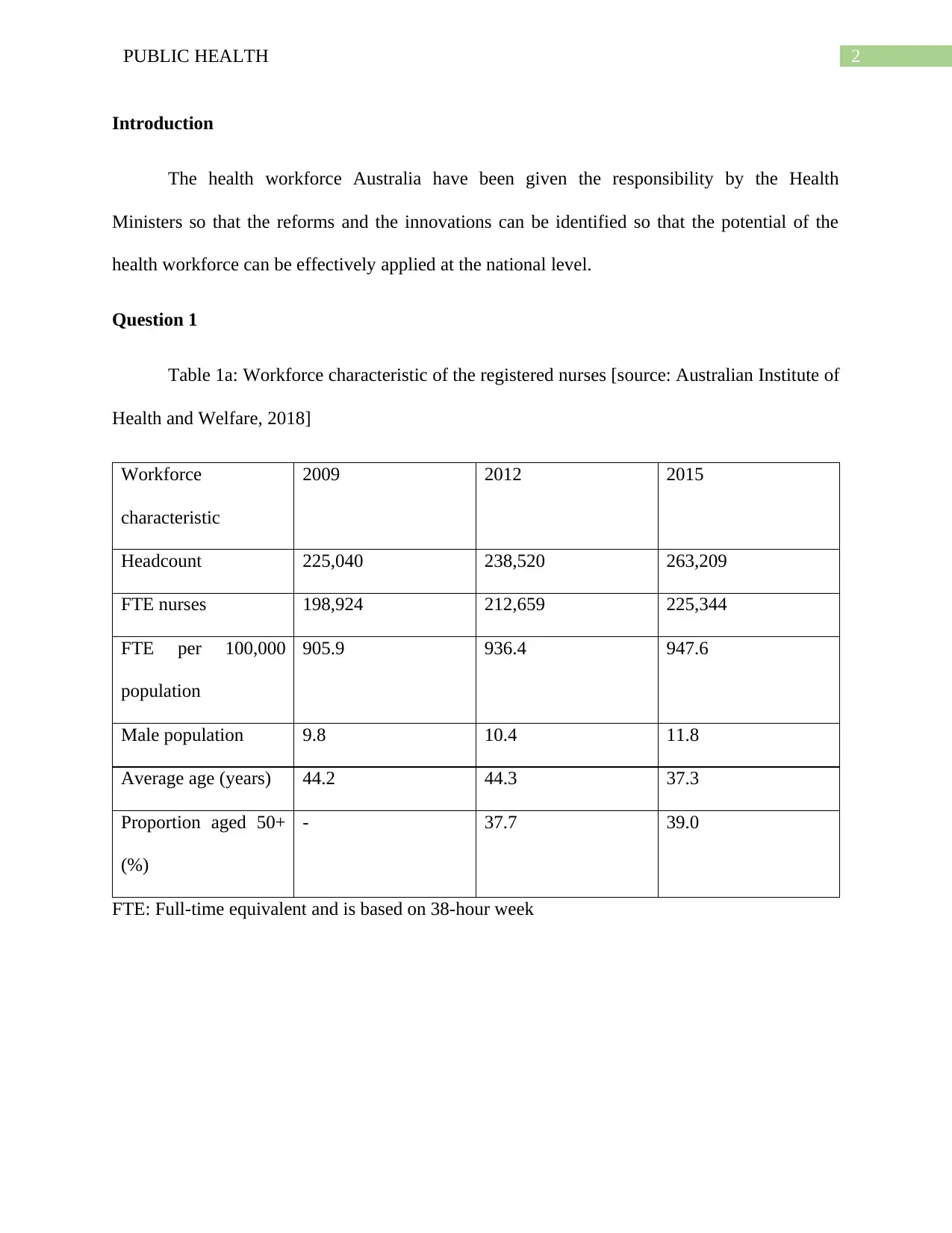
2PUBLIC HEALTH
Introduction
The health workforce Australia have been given the responsibility by the Health
Ministers so that the reforms and the innovations can be identified so that the potential of the
health workforce can be effectively applied at the national level.
Question 1
Table 1a: Workforce characteristic of the registered nurses [source: Australian Institute of
Health and Welfare, 2018]
Workforce
characteristic
2009 2012 2015
Headcount 225,040 238,520 263,209
FTE nurses 198,924 212,659 225,344
FTE per 100,000
population
905.9 936.4 947.6
Male population 9.8 10.4 11.8
Average age (years) 44.2 44.3 37.3
Proportion aged 50+
(%)
- 37.7 39.0
FTE: Full-time equivalent and is based on 38-hour week
Introduction
The health workforce Australia have been given the responsibility by the Health
Ministers so that the reforms and the innovations can be identified so that the potential of the
health workforce can be effectively applied at the national level.
Question 1
Table 1a: Workforce characteristic of the registered nurses [source: Australian Institute of
Health and Welfare, 2018]
Workforce
characteristic
2009 2012 2015
Headcount 225,040 238,520 263,209
FTE nurses 198,924 212,659 225,344
FTE per 100,000
population
905.9 936.4 947.6
Male population 9.8 10.4 11.8
Average age (years) 44.2 44.3 37.3
Proportion aged 50+
(%)
- 37.7 39.0
FTE: Full-time equivalent and is based on 38-hour week

3PUBLIC HEALTH
Table 1b: Workforce characteristic of employed enrolled nurses [source: Australian
Institute of Health and Welfare, 2018]
Workforce
characteristic
2009 2012 2015
Headcount 51,711 51,624 55,383
FTE nurses 43,614 42,467 46,753
FTE per 100,000
population
198.2 187.0 196.6
Male population 8.9 9.2 9.4
Average age (years) 44.9 46.0 44.4
Proportion aged 50+
(%)
- 45.5 39.0
FTE: Full-time equivalent and is based on 38-hour week
Table 1c: Workforce characteristics of all employed nurses [source: Australian Institute
of Health and Welfare, 2018]
Workforce
characteristic
2009 2012 2015
Headcount 276,751 290,144 307,104
FTE nurses 242,521 255,174 270,548
FTE per 100,000
population
1,104 1,123 1,137
Male population 9.6 10.2 10.6
Table 1b: Workforce characteristic of employed enrolled nurses [source: Australian
Institute of Health and Welfare, 2018]
Workforce
characteristic
2009 2012 2015
Headcount 51,711 51,624 55,383
FTE nurses 43,614 42,467 46,753
FTE per 100,000
population
198.2 187.0 196.6
Male population 8.9 9.2 9.4
Average age (years) 44.9 46.0 44.4
Proportion aged 50+
(%)
- 45.5 39.0
FTE: Full-time equivalent and is based on 38-hour week
Table 1c: Workforce characteristics of all employed nurses [source: Australian Institute
of Health and Welfare, 2018]
Workforce
characteristic
2009 2012 2015
Headcount 276,751 290,144 307,104
FTE nurses 242,521 255,174 270,548
FTE per 100,000
population
1,104 1,123 1,137
Male population 9.6 10.2 10.6
Secure Best Marks with AI Grader
Need help grading? Try our AI Grader for instant feedback on your assignments.
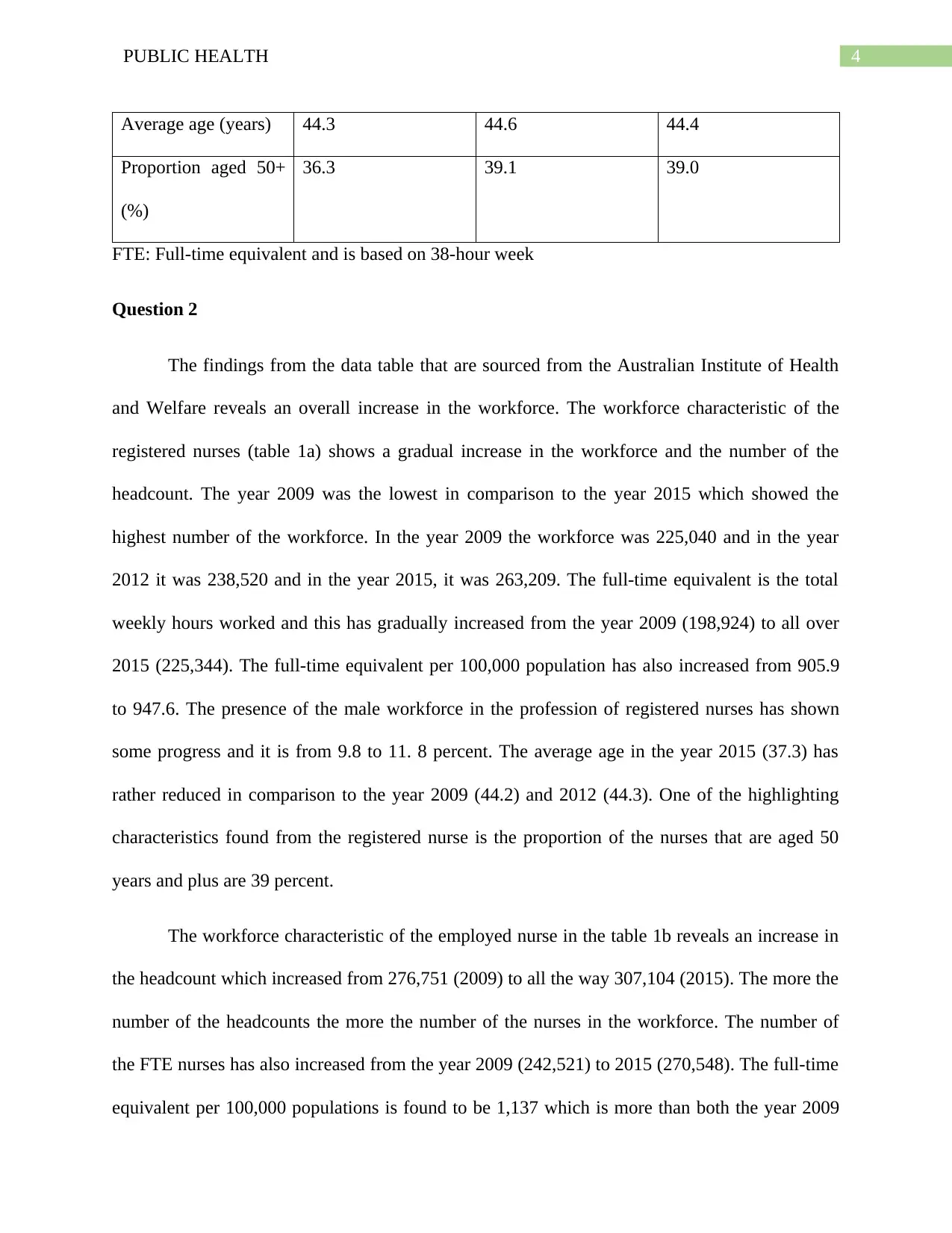
4PUBLIC HEALTH
Average age (years) 44.3 44.6 44.4
Proportion aged 50+
(%)
36.3 39.1 39.0
FTE: Full-time equivalent and is based on 38-hour week
Question 2
The findings from the data table that are sourced from the Australian Institute of Health
and Welfare reveals an overall increase in the workforce. The workforce characteristic of the
registered nurses (table 1a) shows a gradual increase in the workforce and the number of the
headcount. The year 2009 was the lowest in comparison to the year 2015 which showed the
highest number of the workforce. In the year 2009 the workforce was 225,040 and in the year
2012 it was 238,520 and in the year 2015, it was 263,209. The full-time equivalent is the total
weekly hours worked and this has gradually increased from the year 2009 (198,924) to all over
2015 (225,344). The full-time equivalent per 100,000 population has also increased from 905.9
to 947.6. The presence of the male workforce in the profession of registered nurses has shown
some progress and it is from 9.8 to 11. 8 percent. The average age in the year 2015 (37.3) has
rather reduced in comparison to the year 2009 (44.2) and 2012 (44.3). One of the highlighting
characteristics found from the registered nurse is the proportion of the nurses that are aged 50
years and plus are 39 percent.
The workforce characteristic of the employed nurse in the table 1b reveals an increase in
the headcount which increased from 276,751 (2009) to all the way 307,104 (2015). The more the
number of the headcounts the more the number of the nurses in the workforce. The number of
the FTE nurses has also increased from the year 2009 (242,521) to 2015 (270,548). The full-time
equivalent per 100,000 populations is found to be 1,137 which is more than both the year 2009
Average age (years) 44.3 44.6 44.4
Proportion aged 50+
(%)
36.3 39.1 39.0
FTE: Full-time equivalent and is based on 38-hour week
Question 2
The findings from the data table that are sourced from the Australian Institute of Health
and Welfare reveals an overall increase in the workforce. The workforce characteristic of the
registered nurses (table 1a) shows a gradual increase in the workforce and the number of the
headcount. The year 2009 was the lowest in comparison to the year 2015 which showed the
highest number of the workforce. In the year 2009 the workforce was 225,040 and in the year
2012 it was 238,520 and in the year 2015, it was 263,209. The full-time equivalent is the total
weekly hours worked and this has gradually increased from the year 2009 (198,924) to all over
2015 (225,344). The full-time equivalent per 100,000 population has also increased from 905.9
to 947.6. The presence of the male workforce in the profession of registered nurses has shown
some progress and it is from 9.8 to 11. 8 percent. The average age in the year 2015 (37.3) has
rather reduced in comparison to the year 2009 (44.2) and 2012 (44.3). One of the highlighting
characteristics found from the registered nurse is the proportion of the nurses that are aged 50
years and plus are 39 percent.
The workforce characteristic of the employed nurse in the table 1b reveals an increase in
the headcount which increased from 276,751 (2009) to all the way 307,104 (2015). The more the
number of the headcounts the more the number of the nurses in the workforce. The number of
the FTE nurses has also increased from the year 2009 (242,521) to 2015 (270,548). The full-time
equivalent per 100,000 populations is found to be 1,137 which is more than both the year 2009
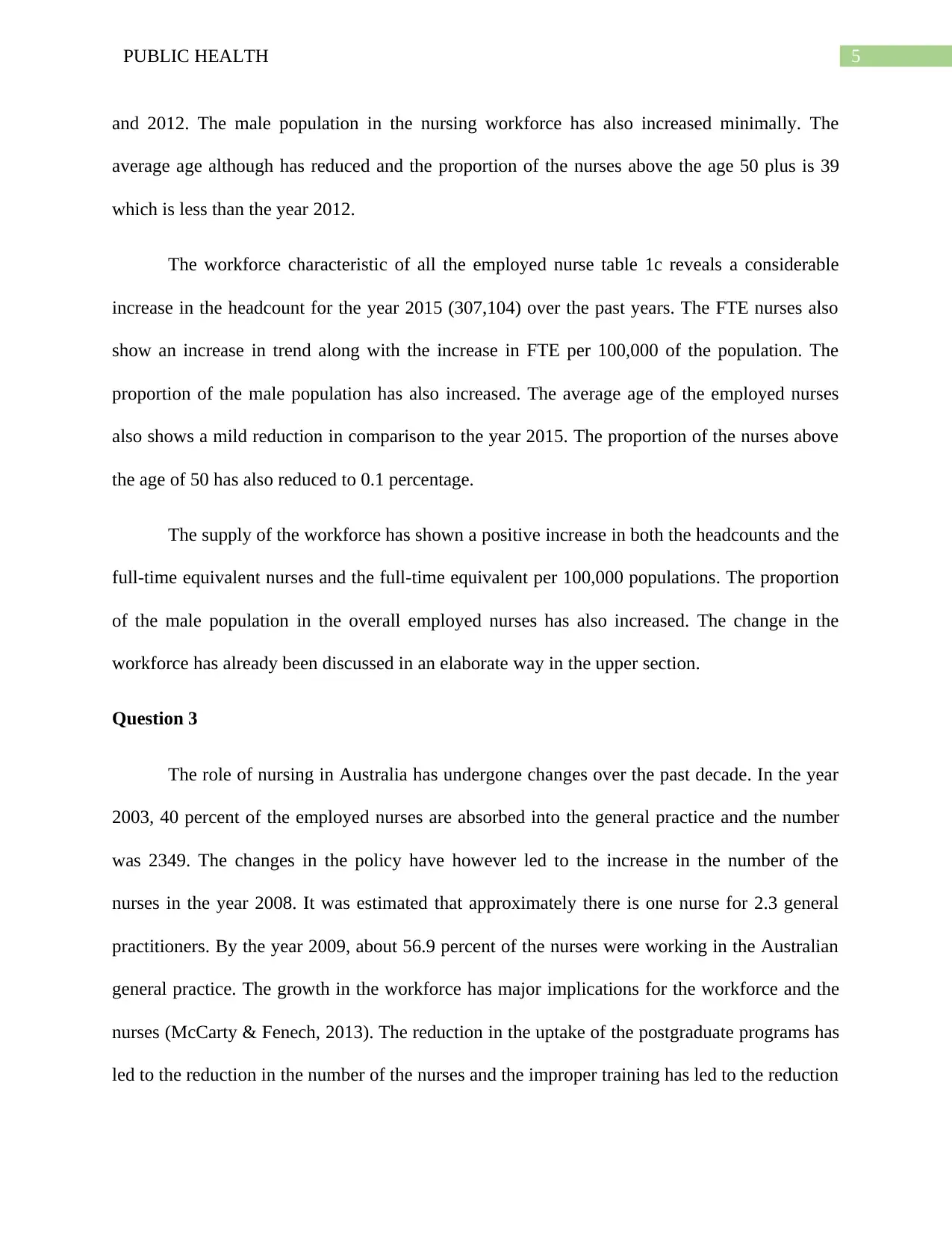
5PUBLIC HEALTH
and 2012. The male population in the nursing workforce has also increased minimally. The
average age although has reduced and the proportion of the nurses above the age 50 plus is 39
which is less than the year 2012.
The workforce characteristic of all the employed nurse table 1c reveals a considerable
increase in the headcount for the year 2015 (307,104) over the past years. The FTE nurses also
show an increase in trend along with the increase in FTE per 100,000 of the population. The
proportion of the male population has also increased. The average age of the employed nurses
also shows a mild reduction in comparison to the year 2015. The proportion of the nurses above
the age of 50 has also reduced to 0.1 percentage.
The supply of the workforce has shown a positive increase in both the headcounts and the
full-time equivalent nurses and the full-time equivalent per 100,000 populations. The proportion
of the male population in the overall employed nurses has also increased. The change in the
workforce has already been discussed in an elaborate way in the upper section.
Question 3
The role of nursing in Australia has undergone changes over the past decade. In the year
2003, 40 percent of the employed nurses are absorbed into the general practice and the number
was 2349. The changes in the policy have however led to the increase in the number of the
nurses in the year 2008. It was estimated that approximately there is one nurse for 2.3 general
practitioners. By the year 2009, about 56.9 percent of the nurses were working in the Australian
general practice. The growth in the workforce has major implications for the workforce and the
nurses (McCarty & Fenech, 2013). The reduction in the uptake of the postgraduate programs has
led to the reduction in the number of the nurses and the improper training has led to the reduction
and 2012. The male population in the nursing workforce has also increased minimally. The
average age although has reduced and the proportion of the nurses above the age 50 plus is 39
which is less than the year 2012.
The workforce characteristic of all the employed nurse table 1c reveals a considerable
increase in the headcount for the year 2015 (307,104) over the past years. The FTE nurses also
show an increase in trend along with the increase in FTE per 100,000 of the population. The
proportion of the male population has also increased. The average age of the employed nurses
also shows a mild reduction in comparison to the year 2015. The proportion of the nurses above
the age of 50 has also reduced to 0.1 percentage.
The supply of the workforce has shown a positive increase in both the headcounts and the
full-time equivalent nurses and the full-time equivalent per 100,000 populations. The proportion
of the male population in the overall employed nurses has also increased. The change in the
workforce has already been discussed in an elaborate way in the upper section.
Question 3
The role of nursing in Australia has undergone changes over the past decade. In the year
2003, 40 percent of the employed nurses are absorbed into the general practice and the number
was 2349. The changes in the policy have however led to the increase in the number of the
nurses in the year 2008. It was estimated that approximately there is one nurse for 2.3 general
practitioners. By the year 2009, about 56.9 percent of the nurses were working in the Australian
general practice. The growth in the workforce has major implications for the workforce and the
nurses (McCarty & Fenech, 2013). The reduction in the uptake of the postgraduate programs has
led to the reduction in the number of the nurses and the improper training has led to the reduction
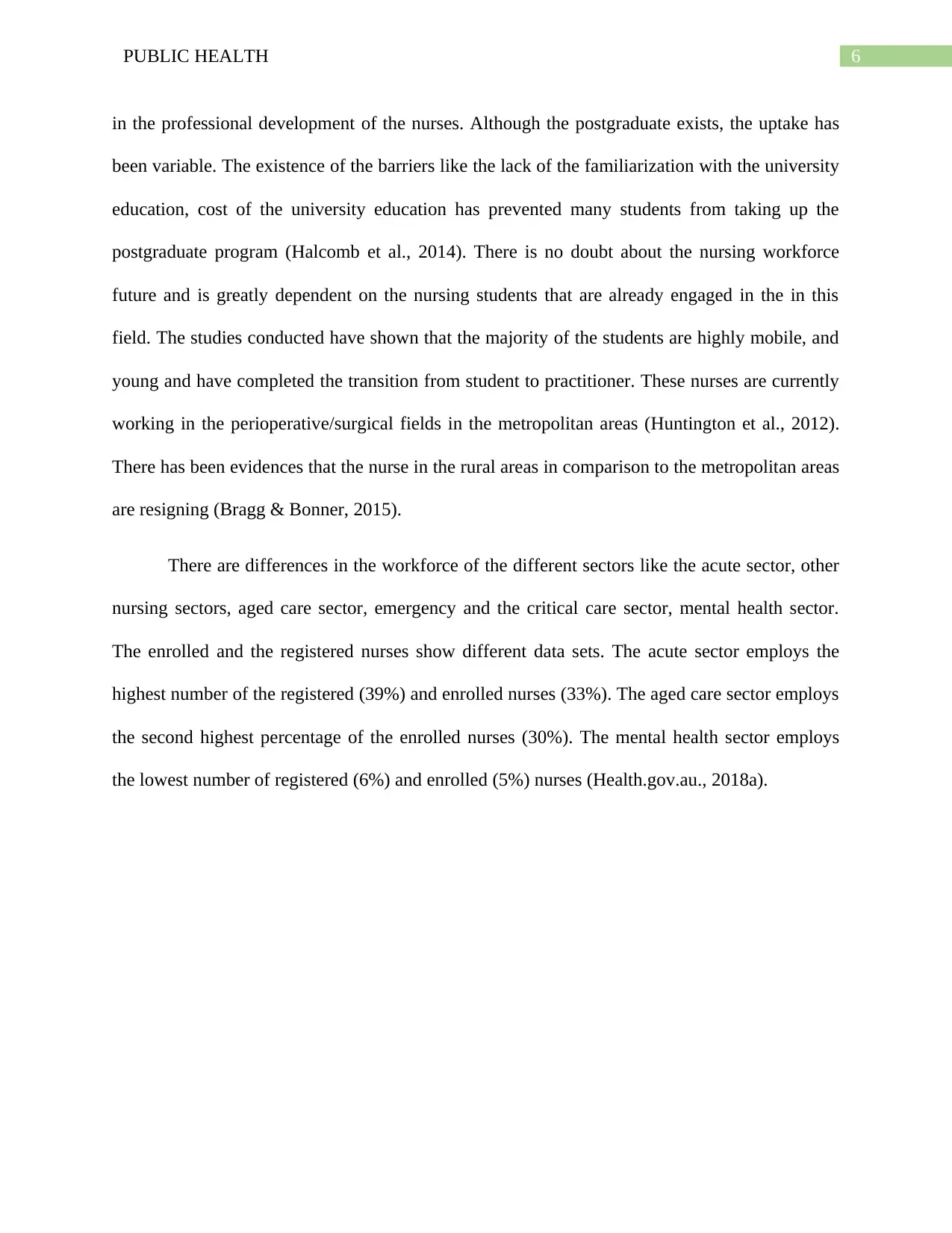
6PUBLIC HEALTH
in the professional development of the nurses. Although the postgraduate exists, the uptake has
been variable. The existence of the barriers like the lack of the familiarization with the university
education, cost of the university education has prevented many students from taking up the
postgraduate program (Halcomb et al., 2014). There is no doubt about the nursing workforce
future and is greatly dependent on the nursing students that are already engaged in the in this
field. The studies conducted have shown that the majority of the students are highly mobile, and
young and have completed the transition from student to practitioner. These nurses are currently
working in the perioperative/surgical fields in the metropolitan areas (Huntington et al., 2012).
There has been evidences that the nurse in the rural areas in comparison to the metropolitan areas
are resigning (Bragg & Bonner, 2015).
There are differences in the workforce of the different sectors like the acute sector, other
nursing sectors, aged care sector, emergency and the critical care sector, mental health sector.
The enrolled and the registered nurses show different data sets. The acute sector employs the
highest number of the registered (39%) and enrolled nurses (33%). The aged care sector employs
the second highest percentage of the enrolled nurses (30%). The mental health sector employs
the lowest number of registered (6%) and enrolled (5%) nurses (Health.gov.au., 2018a).
in the professional development of the nurses. Although the postgraduate exists, the uptake has
been variable. The existence of the barriers like the lack of the familiarization with the university
education, cost of the university education has prevented many students from taking up the
postgraduate program (Halcomb et al., 2014). There is no doubt about the nursing workforce
future and is greatly dependent on the nursing students that are already engaged in the in this
field. The studies conducted have shown that the majority of the students are highly mobile, and
young and have completed the transition from student to practitioner. These nurses are currently
working in the perioperative/surgical fields in the metropolitan areas (Huntington et al., 2012).
There has been evidences that the nurse in the rural areas in comparison to the metropolitan areas
are resigning (Bragg & Bonner, 2015).
There are differences in the workforce of the different sectors like the acute sector, other
nursing sectors, aged care sector, emergency and the critical care sector, mental health sector.
The enrolled and the registered nurses show different data sets. The acute sector employs the
highest number of the registered (39%) and enrolled nurses (33%). The aged care sector employs
the second highest percentage of the enrolled nurses (30%). The mental health sector employs
the lowest number of registered (6%) and enrolled (5%) nurses (Health.gov.au., 2018a).
Paraphrase This Document
Need a fresh take? Get an instant paraphrase of this document with our AI Paraphraser
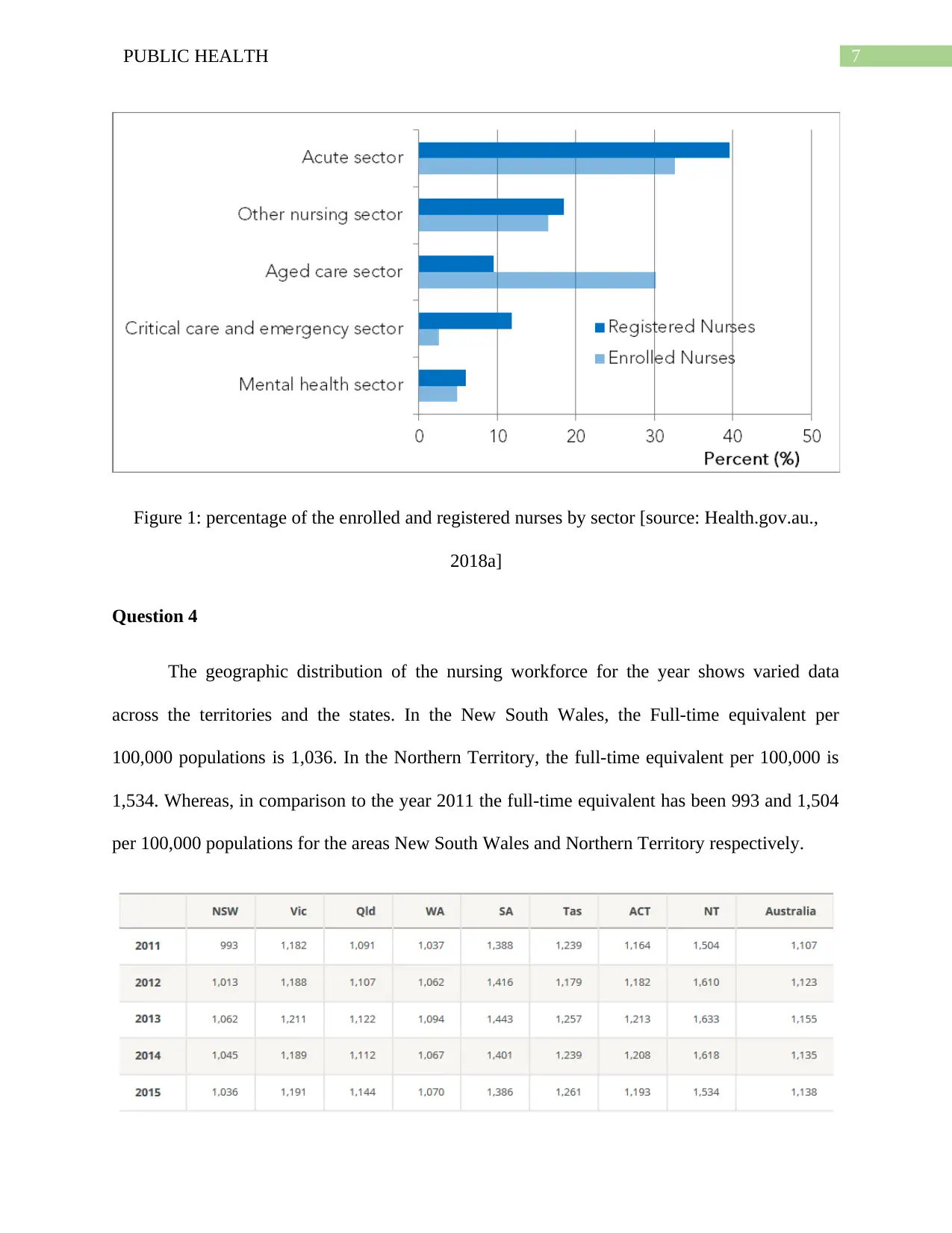
7PUBLIC HEALTH
Figure 1: percentage of the enrolled and registered nurses by sector [source: Health.gov.au.,
2018a]
Question 4
The geographic distribution of the nursing workforce for the year shows varied data
across the territories and the states. In the New South Wales, the Full-time equivalent per
100,000 populations is 1,036. In the Northern Territory, the full-time equivalent per 100,000 is
1,534. Whereas, in comparison to the year 2011 the full-time equivalent has been 993 and 1,504
per 100,000 populations for the areas New South Wales and Northern Territory respectively.
Figure 1: percentage of the enrolled and registered nurses by sector [source: Health.gov.au.,
2018a]
Question 4
The geographic distribution of the nursing workforce for the year shows varied data
across the territories and the states. In the New South Wales, the Full-time equivalent per
100,000 populations is 1,036. In the Northern Territory, the full-time equivalent per 100,000 is
1,534. Whereas, in comparison to the year 2011 the full-time equivalent has been 993 and 1,504
per 100,000 populations for the areas New South Wales and Northern Territory respectively.
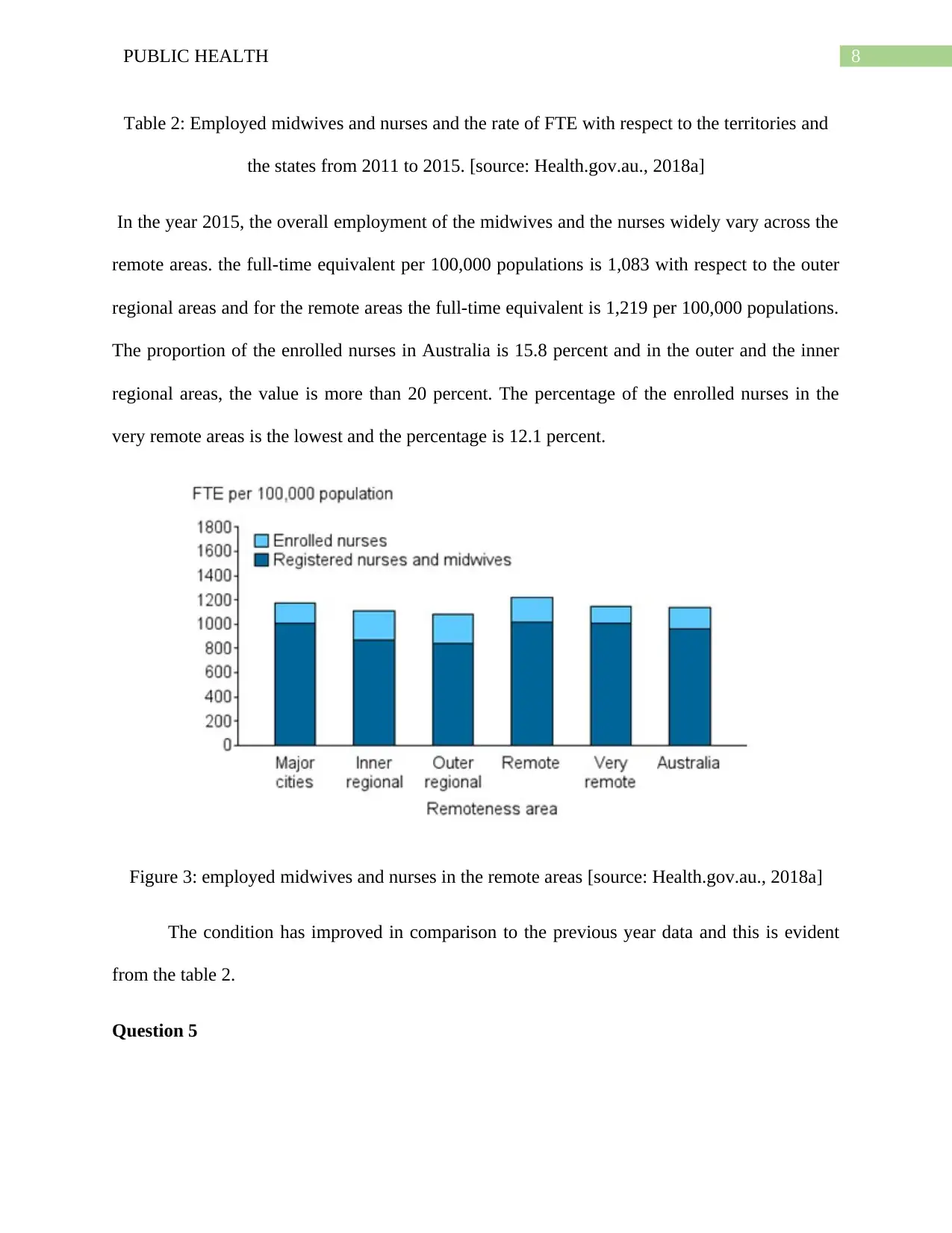
8PUBLIC HEALTH
Table 2: Employed midwives and nurses and the rate of FTE with respect to the territories and
the states from 2011 to 2015. [source: Health.gov.au., 2018a]
In the year 2015, the overall employment of the midwives and the nurses widely vary across the
remote areas. the full-time equivalent per 100,000 populations is 1,083 with respect to the outer
regional areas and for the remote areas the full-time equivalent is 1,219 per 100,000 populations.
The proportion of the enrolled nurses in Australia is 15.8 percent and in the outer and the inner
regional areas, the value is more than 20 percent. The percentage of the enrolled nurses in the
very remote areas is the lowest and the percentage is 12.1 percent.
Figure 3: employed midwives and nurses in the remote areas [source: Health.gov.au., 2018a]
The condition has improved in comparison to the previous year data and this is evident
from the table 2.
Question 5
Table 2: Employed midwives and nurses and the rate of FTE with respect to the territories and
the states from 2011 to 2015. [source: Health.gov.au., 2018a]
In the year 2015, the overall employment of the midwives and the nurses widely vary across the
remote areas. the full-time equivalent per 100,000 populations is 1,083 with respect to the outer
regional areas and for the remote areas the full-time equivalent is 1,219 per 100,000 populations.
The proportion of the enrolled nurses in Australia is 15.8 percent and in the outer and the inner
regional areas, the value is more than 20 percent. The percentage of the enrolled nurses in the
very remote areas is the lowest and the percentage is 12.1 percent.
Figure 3: employed midwives and nurses in the remote areas [source: Health.gov.au., 2018a]
The condition has improved in comparison to the previous year data and this is evident
from the table 2.
Question 5

9PUBLIC HEALTH
The recommendation mentioned in the Nursing Workforce Sustainability Report
highlights the major recommendations like:
Building the workplace capacity (Leadership)- nursing leadership is considered vital for
the improvement of the productivity and retention at the local level. There is a need to
encourage, enable and equip the nurse manager at the levels so that the effective
leadership is promoted in the workplace (Health.gov.au., 2018b).
Workplace support and early career preparation (Retention)- the new nurse that graduate
must be provided with the necessary skill set so that the graduates can meet the service
goals and the standards.
Enabling innovation in the workplace (productivity)- a workplace environment has to be
enabled so that the roles and the skills are able to meet the local needs (Health.gov.au.,
2018b).
The recommendations are still applicable for the year 2018 because even though the
profession has developed over the past few years. The very foundation or the bedrock of the
nursing practices are still based on the nursing leadership, productivity and retention of the
nurses. Thus, the recommendations are still necessary to improve the performance of the nursing
workforce and in bettering the health outcomes (Duckett & Willcox, 2015).
Conclusion
Thus, from the above study, it can be concluded that Australia is facing challenges in the in the
rapidly growing field of healthcare. The demand for the healthcare has increased due to the
ageing population and the and demands a better healthcare outcome, through the increase of
nursing workforce.
The recommendation mentioned in the Nursing Workforce Sustainability Report
highlights the major recommendations like:
Building the workplace capacity (Leadership)- nursing leadership is considered vital for
the improvement of the productivity and retention at the local level. There is a need to
encourage, enable and equip the nurse manager at the levels so that the effective
leadership is promoted in the workplace (Health.gov.au., 2018b).
Workplace support and early career preparation (Retention)- the new nurse that graduate
must be provided with the necessary skill set so that the graduates can meet the service
goals and the standards.
Enabling innovation in the workplace (productivity)- a workplace environment has to be
enabled so that the roles and the skills are able to meet the local needs (Health.gov.au.,
2018b).
The recommendations are still applicable for the year 2018 because even though the
profession has developed over the past few years. The very foundation or the bedrock of the
nursing practices are still based on the nursing leadership, productivity and retention of the
nurses. Thus, the recommendations are still necessary to improve the performance of the nursing
workforce and in bettering the health outcomes (Duckett & Willcox, 2015).
Conclusion
Thus, from the above study, it can be concluded that Australia is facing challenges in the in the
rapidly growing field of healthcare. The demand for the healthcare has increased due to the
ageing population and the and demands a better healthcare outcome, through the increase of
nursing workforce.
Secure Best Marks with AI Grader
Need help grading? Try our AI Grader for instant feedback on your assignments.
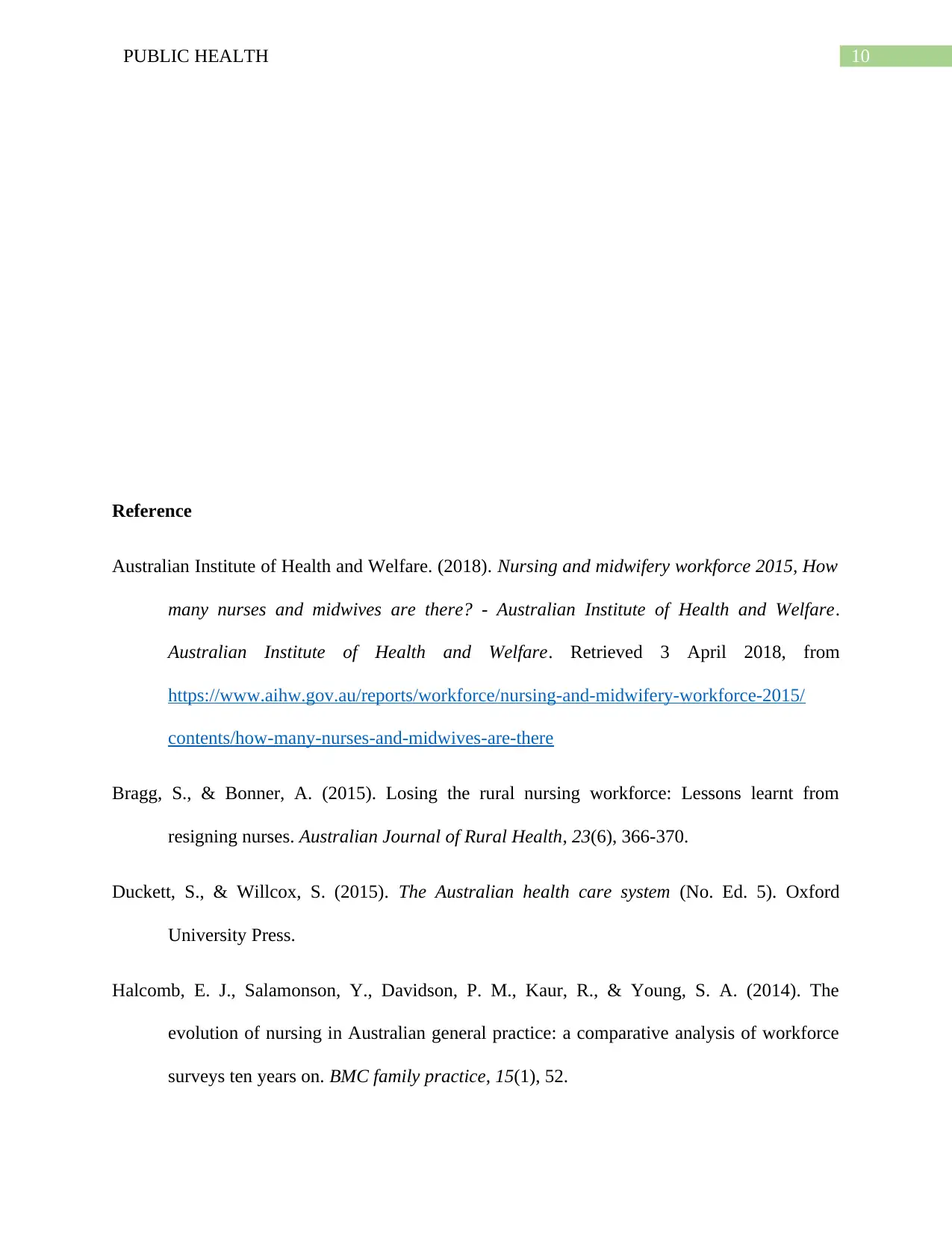
10PUBLIC HEALTH
Reference
Australian Institute of Health and Welfare. (2018). Nursing and midwifery workforce 2015, How
many nurses and midwives are there? - Australian Institute of Health and Welfare.
Australian Institute of Health and Welfare. Retrieved 3 April 2018, from
https://www.aihw.gov.au/reports/workforce/nursing-and-midwifery-workforce-2015/
contents/how-many-nurses-and-midwives-are-there
Bragg, S., & Bonner, A. (2015). Losing the rural nursing workforce: Lessons learnt from
resigning nurses. Australian Journal of Rural Health, 23(6), 366-370.
Duckett, S., & Willcox, S. (2015). The Australian health care system (No. Ed. 5). Oxford
University Press.
Halcomb, E. J., Salamonson, Y., Davidson, P. M., Kaur, R., & Young, S. A. (2014). The
evolution of nursing in Australian general practice: a comparative analysis of workforce
surveys ten years on. BMC family practice, 15(1), 52.
Reference
Australian Institute of Health and Welfare. (2018). Nursing and midwifery workforce 2015, How
many nurses and midwives are there? - Australian Institute of Health and Welfare.
Australian Institute of Health and Welfare. Retrieved 3 April 2018, from
https://www.aihw.gov.au/reports/workforce/nursing-and-midwifery-workforce-2015/
contents/how-many-nurses-and-midwives-are-there
Bragg, S., & Bonner, A. (2015). Losing the rural nursing workforce: Lessons learnt from
resigning nurses. Australian Journal of Rural Health, 23(6), 366-370.
Duckett, S., & Willcox, S. (2015). The Australian health care system (No. Ed. 5). Oxford
University Press.
Halcomb, E. J., Salamonson, Y., Davidson, P. M., Kaur, R., & Young, S. A. (2014). The
evolution of nursing in Australian general practice: a comparative analysis of workforce
surveys ten years on. BMC family practice, 15(1), 52.

11PUBLIC HEALTH
Health.gov.au. (2018a). Health.gov.au. Retrieved 4 April 2018, from
http://www.health.gov.au/internet/main/publishing.nsf/content/34AA7E6FDB8C16AAC
A257D9500112F25/$File/AFHW%20-%20Nurses%20detailed%20report.pdf
Health.gov.au. (2018b). Health.gov.au. Retrieved 4 April 2018, from
https://www.health.gov.au/internet/main/publishing.nsf/Content/29418BA17E67ABC0C
A257D9B00757D08/$File/Nursing%20Workforce%20Sustainability%20-%20Improving
%20Nurse%20Retention%20and%20Productivity%20report.pdf
Huntington, A., Gilmour, J., Neville, S., Kellett, S., & Turner, C. (2012). A glimpse of the future
nursing workforce: the graduate e-cohort study. Australian Journal of Advanced Nursing,
The, 29(3), 22.
McCarty, M. V., & Fenech, B. J. (2013). Towards best practice in national health workforce
planning. The Medical journal of Australia, 199(5), 10-13.
Health.gov.au. (2018a). Health.gov.au. Retrieved 4 April 2018, from
http://www.health.gov.au/internet/main/publishing.nsf/content/34AA7E6FDB8C16AAC
A257D9500112F25/$File/AFHW%20-%20Nurses%20detailed%20report.pdf
Health.gov.au. (2018b). Health.gov.au. Retrieved 4 April 2018, from
https://www.health.gov.au/internet/main/publishing.nsf/Content/29418BA17E67ABC0C
A257D9B00757D08/$File/Nursing%20Workforce%20Sustainability%20-%20Improving
%20Nurse%20Retention%20and%20Productivity%20report.pdf
Huntington, A., Gilmour, J., Neville, S., Kellett, S., & Turner, C. (2012). A glimpse of the future
nursing workforce: the graduate e-cohort study. Australian Journal of Advanced Nursing,
The, 29(3), 22.
McCarty, M. V., & Fenech, B. J. (2013). Towards best practice in national health workforce
planning. The Medical journal of Australia, 199(5), 10-13.
1 out of 12
Your All-in-One AI-Powered Toolkit for Academic Success.
+13062052269
info@desklib.com
Available 24*7 on WhatsApp / Email
![[object Object]](/_next/static/media/star-bottom.7253800d.svg)
Unlock your academic potential
© 2024 | Zucol Services PVT LTD | All rights reserved.
